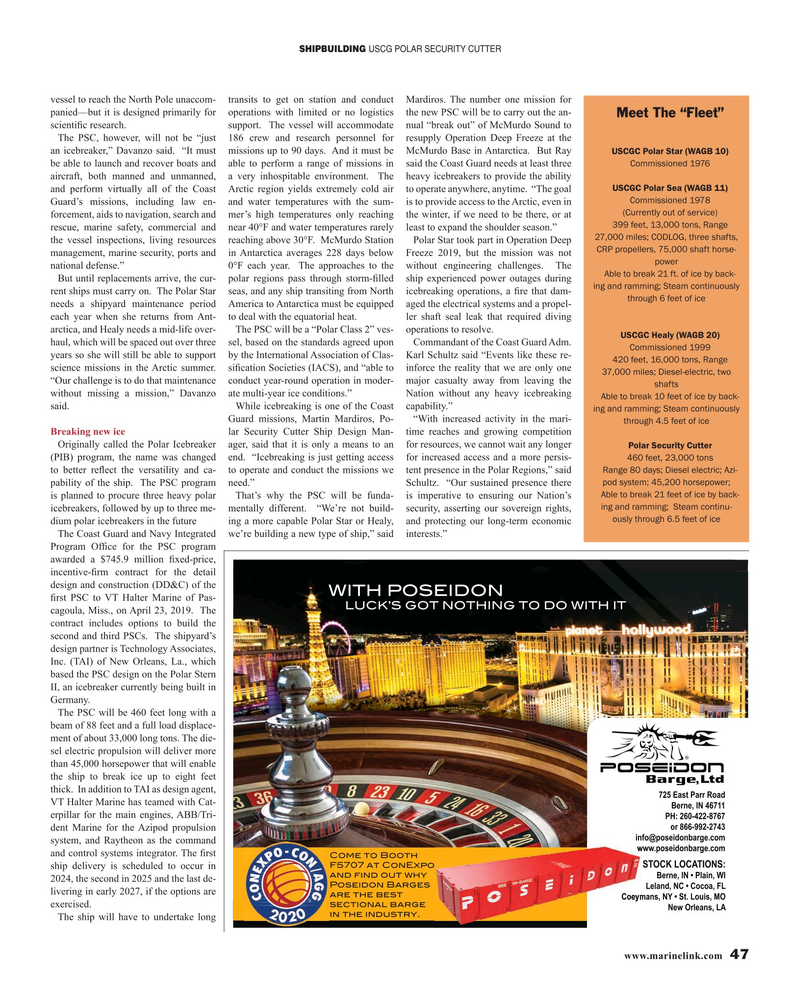
Page 47: of Maritime Reporter Magazine (November 2019)
Workboat Edition
Read this page in Pdf, Flash or Html5 edition of November 2019 Maritime Reporter Magazine
SHIPBUILDING USCG POLAR SECURITY CUTTER vessel to reach the North Pole unaccom- transits to get on station and conduct Mardiros. The number one mission for panied—but it is designed primarily for operations with limited or no logistics the new PSC will be to carry out the an-
Meet The “Fleet” scienti? c research. support. The vessel will accommodate nual “break out” of McMurdo Sound to
The PSC, however, will not be “just 186 crew and research personnel for resupply Operation Deep Freeze at the an icebreaker,” Davanzo said. “It must missions up to 90 days. And it must be McMurdo Base in Antarctica. But Ray
USCGC Polar Star (WAGB 10)
Commissioned 1976 be able to launch and recover boats and able to perform a range of missions in said the Coast Guard needs at least three aircraft, both manned and unmanned, a very inhospitable environment. The heavy icebreakers to provide the ability
USCGC Polar Sea (WAGB 11) and perform virtually all of the Coast Arctic region yields extremely cold air to operate anywhere, anytime. “The goal
Commissioned 1978
Guard’s missions, including law en- and water temperatures with the sum- is to provide access to the Arctic, even in (Currently out of service) forcement, aids to navigation, search and mer’s high temperatures only reaching the winter, if we need to be there, or at 399 feet, 13,000 tons, Range rescue, marine safety, commercial and near 40°F and water temperatures rarely least to expand the shoulder season.” 27,000 miles; CODLOG, three shafts, the vessel inspections, living resources reaching above 30°F. McMurdo Station Polar Star took part in Operation Deep
CRP propellers, 75,000 shaft horse- management, marine security, ports and in Antarctica averages 228 days below Freeze 2019, but the mission was not power national defense.” 0°F each year. The approaches to the without engineering challenges. The
Able to break 21 ft. of ice by back-
But until replacements arrive, the cur- polar regions pass through storm-? lled ship experienced power outages during ing and ramming; Steam continuously rent ships must carry on. The Polar Star seas, and any ship transiting from North icebreaking operations, a ? re that dam- through 6 feet of ice needs a shipyard maintenance period America to Antarctica must be equipped aged the electrical systems and a propel- each year when she returns from Ant- to deal with the equatorial heat. ler shaft seal leak that required diving arctica, and Healy needs a mid-life over- The PSC will be a “Polar Class 2” ves- operations to resolve.
USCGC Healy (WAGB 20) haul, which will be spaced out over three sel, based on the standards agreed upon Commandant of the Coast Guard Adm.
Commissioned 1999 years so she will still be able to support by the International Association of Clas- Karl Schultz said “Events like these re- 420 feet, 16,000 tons, Range science missions in the Arctic summer. si? cation Societies (IACS), and “able to inforce the reality that we are only one 37,000 miles; Diesel-electric, two “Our challenge is to do that maintenance conduct year-round operation in moder- major casualty away from leaving the shafts without missing a mission,” Davanzo ate multi-year ice conditions.” Nation without any heavy icebreaking
Able to break 10 feet of ice by back- said. While icebreaking is one of the Coast capability.” ing and ramming; Steam continuously
Guard missions, Martin Mardiros, Po- “With increased activity in the mari- through 4.5 feet of ice
Breaking new ice lar Security Cutter Ship Design Man- time reaches and growing competition
Originally called the Polar Icebreaker ager, said that it is only a means to an for resources, we cannot wait any longer
Polar Security Cutter (PIB) program, the name was changed end. “Icebreaking is just getting access for increased access and a more persis- 460 feet, 23,000 tons
Range 80 days; Diesel electric; Azi- to better re? ect the versatility and ca- to operate and conduct the missions we tent presence in the Polar Regions,” said pod system; 45,200 horsepower; pability of the ship. The PSC program need.” Schultz. “Our sustained presence there
Able to break 21 feet of ice by back- is planned to procure three heavy polar That’s why the PSC will be funda- is imperative to ensuring our Nation’s ing and ramming; Steam continu- icebreakers, followed by up to three me- mentally different. “We’re not build- security, asserting our sovereign rights, ously through 6.5 feet of ice dium polar icebreakers in the future ing a more capable Polar Star or Healy, and protecting our long-term economic
The Coast Guard and Navy Integrated we’re building a new type of ship,” said interests.”
Program Of? ce for the PSC program awarded a $745.9 million ? xed-price, incentive-? rm contract for the detail design and construction (DD&C) of the ? rst PSC to VT Halter Marine of Pas- cagoula, Miss., on April 23, 2019. The contract includes options to build the second and third PSCs. The shipyard’s design partner is Technology Associates,
Inc. (TAI) of New Orleans, La., which based the PSC design on the Polar Stern
II, an icebreaker currently being built in
Germany.
The PSC will be 460 feet long with a beam of 88 feet and a full load displace- ment of about 33,000 long tons. The die- sel electric propulsion will deliver more than 45,000 horsepower that will enable the ship to break ice up to eight feet thick. In addition to TAI as design agent,
VT Halter Marine has teamed with Cat- erpillar for the main engines, ABB/Tri- dent Marine for the Azipod propulsion system, and Raytheon as the command and control systems integrator. The ? rst ship delivery is scheduled to occur in 2024, the second in 2025 and the last de- livering in early 2027, if the options are exercised.
The ship will have to undertake long www.marinelink.com 47
MR #11 (42-49).indd 47 10/30/2019 10:05:22 AM

 46
46

 48
48
